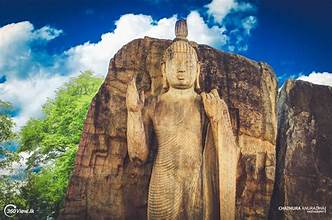…The Aukana Buddha Statue…
The Aukana Buddha Statue: A Masterpiece of Ancient Sri Lankan Sculpture
Sri Lanka, a land renowned for its rich Buddhist heritage, is home to many awe-inspiring monuments. One such monumental statue is the Aukana Buddha Statue, an impressive figure of serene tranquility and artistic excellence. Located in the North Central Province of Sri Lanka, this ancient statue stands as a testament to the country’s artistic and religious legacy, dating back to the 5th century CE.
History and Origin
The Aukana Buddha Statue was carved during the reign of King Dhatusena (r. 459–477 CE), who is credited with the creation of many significant religious and architectural structures in Sri Lanka. The statue was likely constructed as part of the king’s efforts to promote Buddhism across the island. It is believed to have been built in the 5th century, making it one of the oldest and best-preserved Buddha statues in Sri Lanka.
The statue is located near the town of Aukana, which is situated about 30 kilometers north of the ancient city of Anuradhapura. The site is surrounded by serene natural landscapes, enhancing the spiritual experience for visitors. The statue’s location, carved from a massive granite rock, was carefully chosen to allow the Buddha to be seen from a distance, symbolizing the Buddha’s watchful and compassionate presence over the land.
Description and Significance
The Aukana Buddha Statue stands at an impressive height of 12 meters (39 feet), making it one of the tallest statues of the Buddha in Sri Lanka. It is carved out of a single granite stone and stands in a posture known as Abhaya Mudra, which symbolizes the gesture of fearlessness. This posture, with the right hand raised and palm facing outwards, is one of the most iconic symbols of the Buddha, representing peace, protection, and tranquility.
The statue is remarkable not only for its size but also for its artistic intricacy. The serene expression on the Buddha’s face and the graceful draping of the robes reflect the high level of skill and attention to detail achieved by the sculptors of the time. The fine lines of the robe, the gentle curvature of the body, and the peaceful aura of the figure all point to the Buddhist ideals of harmony and serenity.
The Abhaya Mudra posture is particularly significant in Buddhist iconography, as it is associated with the Buddha’s ability to conquer fear and bring peace to his followers. The Aukana Buddha, in its towering presence, embodies these ideals and serves as a symbol of Buddha’s teachings and enlightenment.
Architectural and Artistic Excellence
The Aukana Buddha Statue is a stunning example of ancient Sri Lankan rock-cut sculpture. Unlike many statues that were molded or cast, the Aukana statue was painstakingly carved from a single granite monolith. The artisans of the time employed advanced techniques to free the figure from the surrounding rock, creating a seamless and imposing structure that stands out in its natural environment.
The statue is also notable for its proportional accuracy and attention to detail, demonstrating the high level of craftsmanship achieved by the ancient Sri Lankan sculptors. The flowing lines of the robes, the folds in the fabric, and the naturalistic depiction of the Buddha’s posture all reflect the artistic conventions of the time, yet retain a distinctive Sri Lankan style.
Additionally, the site includes a small vihara (monastic complex) where monks once resided and meditated. The surrounding area is also home to smaller figures and remains of ancient structures, highlighting the significance of the site as a place of worship and meditation in ancient Sri Lanka.
Cultural and Religious Importance
The Aukana Buddha Statue is not only a masterpiece of ancient art but also a deeply significant religious symbol. It represents the spiritual ideals of Buddhism and serves as a reminder of the Buddha’s teachings on compassion, fearlessness, and inner peace. The statue has long been a place of pilgrimage for Buddhists in Sri Lanka, drawing devotees who come to pay their respects and seek spiritual solace.
The statue is also a symbol of the island’s enduring Buddhist heritage, reflecting the commitment of ancient Sri Lankan kings and artisans to the preservation and promotion of the teachings of the Buddha. The site continues to attract visitors from around the world, offering a sense of peace and inspiration to those who encounter it.
Visiting the Aukana Buddha Statue
For those visiting the Aukana Buddha Statue, the journey is as much about experiencing the natural beauty of the surrounding area as it is about appreciating the monument itself. The site is situated in a tranquil and scenic location, making it an ideal destination for those interested in both history and nature.
Visitors can approach the statue along a path that winds through lush greenery, eventually leading them to the foot of the statue. The statue is set in an open area, allowing for a panoramic view of the surroundings. There is also a small museum nearby that provides further information about the statue’s history and significance.
The best time to visit the Aukana Buddha Statue is during the cooler months, as the site can become quite hot and dry during the peak of summer. It is recommended to wear modest clothing when visiting the statue, as it is a sacred site.
Conclusion
The Aukana Buddha Statue stands as one of Sri Lanka’s finest examples of ancient Buddhist sculpture and continues to inspire awe and reverence. Its majestic presence, along with its artistic and religious significance, makes it a must-visit site for anyone interested in Sri Lanka’s rich cultural and religious history. The statue is not just a marvel of ancient craftsmanship but also a powerful symbol of peace, serenity, and the eternal teachings of the Buddha.

